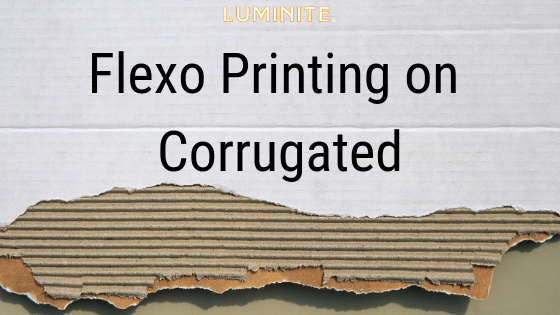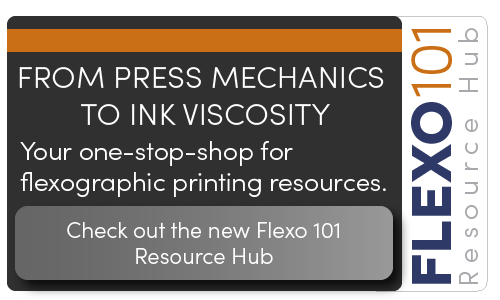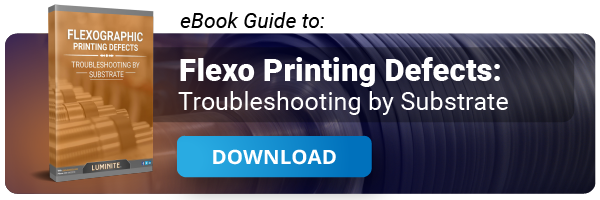Share this
Ultimate Guide to Corrugated Packaging Printing With Flexo
by Luminite on Jul 12, 2022 3:00:00 PM

Corrugated packaging and printing have come a long way in recent years. Although durable during shipping, corrugated substrates are spongy and can be easily crushed during an indelicate printing process.
As a result, businesses once had to settle for product shipping and display boxes printed with dull, low-resolution images and text that were less appealing to consumers.
Today's advanced technologies and materials have revolutionized corrugated packaging printing. Thanks to these advances, plus the ever-increasing capabilities of flexo, brands can simultaneously use corrugated product boxes to increase product visibility and promote a brand’s awareness. This is, of course, in addition to benefiting from the material's combination of lightness and durability, which is ideal for shipping.
The variety of available processes and materials have created several methods for printing on corrugated material. Types of printing on corrugated boxes include:
- Flexography (flexo)
- Offset lithography (litho)
- Screen printing
- Digital printing
Due to its versatility, flexographic printing has become one of the most commonly utilized.
What Is Flexo Printing?
In Flexo printing, an imaged sleeve, cylinder, or plate applies graphics or text onto a substrate. Flexo printers use image carriers made from elastomers or other polymer materials. These image carriers have raised areas that depict your artwork and are adhered to rolling cylinders.
Ink is metered directly onto the image carrier, by another cylinder called an anilox. As the image carrier cylinder rotates, it transfers the image onto a moving substrate.
Flexo works well for printing directly onto corrugated, or onto another substrate, which is later laminated to the final product.
A speedy printing process, flexo uses quick-drying inks and works on many types of absorbent and non-absorbent materials. Thanks to its versatility, resilience, and quick print times, flexo is widely considered the best printing option for high-volume custom corrugated jobs.
Examples of corrugated products appropriate for flexo printing include:
- Shipping boxes
- Pre-printed liner board
- In-store displays
- Subscription boxes
- Jewelry boxes
- Point of purchase displays
- Clothing boxes
- Bakery boxes
- + More
Want to learn more about flexography? Check out our new Flexo101 Resource Hub below:
Corrugated Packaging Printing Methods
There are two primary methods to flexo print on corrugated materials:
- Direct printing
- Pre-printing
As its name suggests, direct printing prints directly onto the corrugated final product. Pre-printing prints onto a smoother substrate, which is then laminated to the final product.
Flexo printing's versatile image carriers easily handle either method.
Key Considerations for Corrugated Packaging Printing With Flexo
The most important components to consider in corrugated packaging design include:
- Artwork specifications
- Setup considerations
- Ink type
- Image carrier materials
- Number of image carriers needed
Careful consideration of these corrugated printing tips will help you budget for product packaging and printing costs, design your artwork, and select an ideal printing method.
Flexo Color Guide for Printing Inks on Corrugated
- When flexo printing on corrugated boxes, each color requires a different image carrier. A four-color print requires four image carriers. Remember to consider the cost of color when designing your artwork. Factor in the price of purchasing and setting up multiple image carriers, and inks, into your packaging budget.
- In cases when you are printing directly on corrugated, it may be difficult – not impossible – to produce some effects, such as gradients and tints. When preparing an artwork file for direct flexo corrugated printing, the aid of a professional designer may help you achieve quality results.
- When selecting colors for your design, consider the color of your substrate, as ink will appear either darker or lighter when applied to a brown or white surface.
- It is recommended to keep the graphics simple with flexography printed directly on corrugated. With direct printing methods, photo-finished images can be difficult to accurately render.
- The higher the grade and the finer the fluting of the corrugated you select, the superior the registration and quality of your print work.
- If you are printing onto a smooth substrate and then laminating that onto your final product (pre-printing), you will be able to render more complex designs.
- When finalizing your design, remember that new graphics require new printing image carriers. To reduce costs, love your package design before purchasing image carriers.
Ink Choices for Flexo Printing on Corrugated
Choosing the right ink for your project seems like a no-brainer, but ensuring that you have the right ink for your specific project will help you avoid poor print results and costly re-works.
Different types of flexographic inks will work well on different corrugated products. Ink compatibility depends on the surface tension of the substrate and the rest of the ink chain.
With the highest surface tension of all, water-based inks are commonly used for corrugated substrates.
Flexo Image Carrier Choice
Flexographic image carriers are generally composed of two different materials:
- Elastomer
- Photopolymer
Both image carrier fabrications have their own set of benefits and drawbacks, but printers typically prefer elastomer image carriers for most corrugated printing jobs.
Not only is the elastomer manufacturing process very environmentally-friendly, these image carriers also feature superior ink transfer and resiliency -- making them more cost-effective for the high-volume print jobs required in packaging.
Corrugated Packing Printing – Yes, It Can Be Done With Flexo!
Whether you choose to render high-quality, photo-like images with a pre-printing flexographic process or decide to print graphic designs directly onto your corrugated packages, flexo can work for you.
With its versatile capabilities, time-tested processes, and durable printing materials, flexo can render your company, brand, and products in stunning color, while building consumer trust and brand recognition for years to come.
Still getting the hang of how to print on corrugated plastic or cardboard? Are you currently using flexo to print on corrugated board and seeing final prints come out differently than you intended? Check out our printing defects guide to troubleshoot, and give a corrugated printing/flexo expert a call if you have any questions!
(Editor's note: This article was originally published in October 2018 and was updated in July, 2022.)
Share this
- Flexographic Printing (81)
- Image Carrier (28)
- Elastomer sleeves (27)
- Ink Transfer (25)
- Quality (22)
- Flexo sleeve (20)
- News (18)
- printing defects (18)
- flexo printing defects (17)
- sustainability (13)
- Flexo Troubleshooting (12)
- Ink (12)
- Digital Printing (10)
- Flexo 101 (10)
- Flexo Inks, (9)
- Anilox (7)
- Blister Packaging (7)
- Cost (6)
- print misregistration (6)
- regulations (6)
- Corrugated Printing (4)
- pinholing (4)
- "Tradeshow (3)
- Digital Flexo (3)
- Gravure Printing (3)
- Insider (3)
- Load-N-Lok (3)
- Wide Web (3)
- direct laser engraving (3)
- flexo-equipment-accessories (3)
- gear marks (3)
- halo (3)
- testing (3)
- Narrow Web (2)
- bridging (2)
- feathering (2)
- filling in (2)
- mottled image (2)
- pressure (2)
- Labelexpo (1)
- dirty prints (1)
- doughnuts (1)
- embossing (1)
- kiss impression (1)
- October 2023 (2)
- September 2023 (1)
- August 2023 (1)
- July 2023 (3)
- June 2023 (1)
- May 2023 (5)
- April 2023 (1)
- March 2023 (2)
- February 2023 (1)
- January 2023 (3)
- December 2022 (1)
- October 2022 (3)
- September 2022 (2)
- August 2022 (2)
- July 2022 (3)
- May 2022 (1)
- April 2022 (4)
- March 2022 (2)
- February 2022 (5)
- January 2022 (7)
- December 2021 (1)
- November 2021 (3)
- October 2021 (2)
- September 2021 (1)
- August 2021 (1)
- July 2021 (3)
- June 2021 (1)
- May 2021 (4)
- April 2021 (4)
- March 2021 (4)
- February 2021 (2)
- December 2020 (1)
- November 2020 (1)
- October 2020 (2)
- September 2020 (1)
- August 2020 (3)
- July 2020 (2)
- June 2020 (3)
- May 2020 (1)
- April 2020 (1)
- November 2019 (3)
- October 2019 (1)
- August 2019 (1)
- July 2019 (1)
- April 2019 (1)
- March 2019 (1)
- January 2019 (1)
- October 2018 (2)
- August 2018 (1)
- July 2018 (1)
- June 2018 (1)
- February 2018 (2)
- October 2017 (1)
- September 2017 (2)
- January 2016 (1)
- February 2015 (1)
- January 2015 (1)
- December 2014 (2)
- September 2014 (1)
- February 2014 (1)
- January 2014 (1)
- December 2013 (3)
- October 2013 (1)
- September 2013 (1)
- June 2013 (1)
- January 2013 (1)



Comments (7)